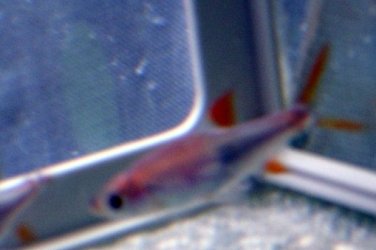toadie
New Member
Three of my 9 neons have shredded looking tails. I don't see any redness, cotton-looking fluff, or other signs of disease. 2 of the harlequin rasboras have shredded tails, but both have white cottony looking stuff on the base of the tail - where it meets the body - and their tails are quite shredded.
My LFS guy thought that with the water stats (pH 8, NO2 below 0.3 ppm and NO3 at/below 0 ppm) that it was unlikely that they had fin rot and that one of the other fish was biting or niping at the tetras - this was before the rasboras went downhill fast.
I isolated the tetras (just in a breeding/net bin) and added Pimafix (antifungal) at his suggestion, but after a week the tetras fins were no better and I noticed that 2 of the rasboras were having fin problems too.
I'm still treating with Pimafix (no change) and just did a dipped the 2 rasboras in a salt dip for 5 minutes. They're now in the net/breeding pen and the bottom is littered with fin parts - after the dip - while that was happening they were shimmying around like they were trying to shake stuff off their tails.
Is this fin rot? What should I do? Could the high pH be the problem? The water quality is consistently quite good and I can't figure out why I'd get a disease associated with stress or poor water quality.
I've not lost any fish for at least 6 months (a neon tetra to NTD and 2 of the corys for reasons unknown).
I have a few live plants, do 25% water changes weekly, the pH is a concern to me (8.0), feed small amounts 2x day and also have black skirt tetras (3) a total of 5 rasboras, one 3-line cory, and 2 small plecos. The tank is 30 gallons. I'm having a hard time eradicating the little green dot algae, and battle a few snails that hitched rides on my plants, but all else is fine.
Please advise.
My LFS guy thought that with the water stats (pH 8, NO2 below 0.3 ppm and NO3 at/below 0 ppm) that it was unlikely that they had fin rot and that one of the other fish was biting or niping at the tetras - this was before the rasboras went downhill fast.
I isolated the tetras (just in a breeding/net bin) and added Pimafix (antifungal) at his suggestion, but after a week the tetras fins were no better and I noticed that 2 of the rasboras were having fin problems too.
I'm still treating with Pimafix (no change) and just did a dipped the 2 rasboras in a salt dip for 5 minutes. They're now in the net/breeding pen and the bottom is littered with fin parts - after the dip - while that was happening they were shimmying around like they were trying to shake stuff off their tails.
Is this fin rot? What should I do? Could the high pH be the problem? The water quality is consistently quite good and I can't figure out why I'd get a disease associated with stress or poor water quality.
I've not lost any fish for at least 6 months (a neon tetra to NTD and 2 of the corys for reasons unknown).
I have a few live plants, do 25% water changes weekly, the pH is a concern to me (8.0), feed small amounts 2x day and also have black skirt tetras (3) a total of 5 rasboras, one 3-line cory, and 2 small plecos. The tank is 30 gallons. I'm having a hard time eradicating the little green dot algae, and battle a few snails that hitched rides on my plants, but all else is fine.
Please advise.


 I'm sorry for your loss.
I'm sorry for your loss.